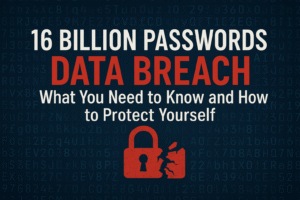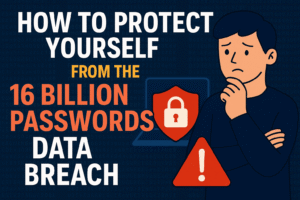16 Billion Passwords Data Breach: The Shocking Reality and How to Protect Yourself

The 16 billion passwords data breach is one of the largest data compromises in history, affecting millions of accounts across popular platforms. In 2025, cybersecurity experts discovered that over 16 billion login credentials from major companies like Apple, Google, and Facebook were exposed. In this article, we’ll break down the 16 billion passwords data breach, what happened, and how you can protect yourself from future risks.
What Is the 16 Billion Passwords Data Breach?
The 16 billion passwords data breach occurred due to a series of infostealer malware attacks. These malware programs are designed to steal sensitive information like usernames, passwords, and other credentials from users’ devices. Once compromised, the stolen data is uploaded to remote servers, where cybercriminals can access it.
Researchers uncovered over 30 datasets, containing billions of records of sensitive user data. This 16 billion passwords data breach is particularly alarming because the data is fresh, meaning that the compromised credentials are still active and usable by malicious actors. Unlike previous breaches involving outdated or recycled data, this is actionable data that can be used to directly compromise accounts.
What Was Exposed in the 16 Billion Passwords Data Breach?
The 16 billion passwords data breach affected accounts from multiple well-known platforms:
-
Social Media: Platforms like Facebook, Instagram, and Telegram had user credentials compromised.
-
Tech Giants: Apple and Google accounts were included, compromising cloud storage and email information.
-
Government Services: Accounts linked to various government services were also exposed.
Given the widespread impact of this breach, it’s essential to take swift action to safeguard your accounts. Read more about how infostealer malware works in this comprehensive guide.
How to Protect Yourself from the 16 Billion Passwords Data Breach

The 16 billion passwords data breach has left millions of people vulnerable to cybercrime. To ensure that your data remains safe, take the following steps immediately:
1. Change Your Passwords Immediately
The first step in securing your accounts is changing your passwords. Start with your most important accounts, such as email, social media, and banking. Use strong, unique passwords that combine numbers, symbols, and both uppercase and lowercase letters. Make sure your new passwords are not similar to previous ones to avoid the risk of being hacked again.
2. Enable Multi-Factor Authentication (MFA)
Multi-Factor Authentication (MFA) is one of the most effective ways to protect your accounts from unauthorized access. MFA requires two forms of verification—something you know (your password) and something you have (like your phone or an authentication app). This extra layer of security makes it much harder for attackers to access your accounts, even if they have your stolen credentials.
To learn more about how to set up MFA, check out the official guide on Google’s support page.
3. Use a Password Manager
A password manager is essential for managing and securing your passwords. These tools can generate complex passwords and store them securely, so you don’t need to worry about remembering or reusing passwords. Password managers also help you easily update and organize your passwords, ensuring you’re always using unique and strong credentials across platforms.
Check out our recommended password managers in this security guide.
4. Monitor Your Accounts for Suspicious Activity
After the 16 billion passwords data breach, it’s important to stay vigilant. Regularly check your accounts for unusual activity, such as unfamiliar login locations, unauthorized transactions, or unexpected changes in account settings. If you notice anything suspicious, take immediate action by changing your password and contacting the platform’s support team.
5. Beware of Phishing Scams
Given the scale of this breach, attackers will likely attempt to use phishing scams to trick you into revealing further information. Always be cautious of unsolicited emails or messages that ask you to click links or provide personal information. If you receive a suspicious message, do not engage. Instead, contact the platform directly to verify the legitimacy of the request.
For more information on phishing and how to recognize malicious messages, refer to this comprehensive phishing guide.
How to Check if You’ve Been Affected by the 16 Billion Passwords Data Breach
If you’re unsure whether your credentials were part of the 16 billion passwords data breach, you can use Have I Been Pwned to check whether your email address or passwords have been exposed in past data breaches. This free service allows you to search your email address and see if your information has been compromised in any previous breaches.
Additionally, check out this report from Cybernews to learn more about the breach and how to safeguard your accounts.
Internal Resources to Help You Stay Secure
We’ve covered the immediate steps you need to take to protect yourself from the 16 billion passwords data breach. For ongoing updates and additional security tips, check out the following resources:
Conclusion
The 16 billion passwords data breach is a significant cybersecurity incident that has exposed millions of users to risk. By taking immediate action to change your passwords, enabling multi-factor authentication, and using password managers, you can greatly reduce the chances of your accounts being compromised. Stay vigilant, monitor your accounts regularly, and be aware of phishing attempts in the aftermath of this breach.
For further updates and detailed information on protecting your digital security, make sure to follow our ongoing coverage on cybersecurity and data breaches.

